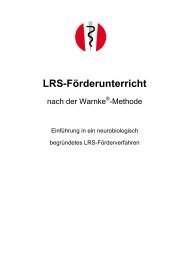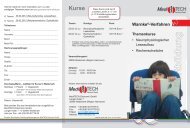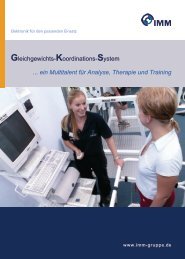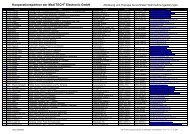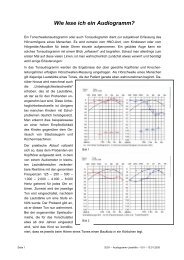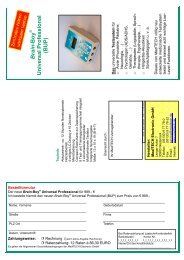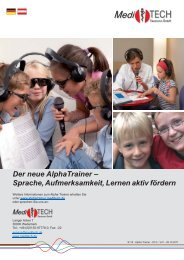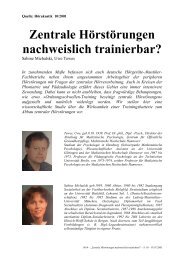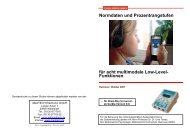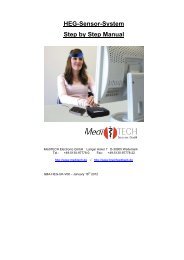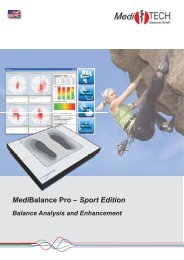HEG-System - MediTECH Electronic GmbH
HEG-System - MediTECH Electronic GmbH
HEG-System - MediTECH Electronic GmbH
Create successful ePaper yourself
Turn your PDF publications into a flip-book with our unique Google optimized e-Paper software.
Customer Information Folder<br />
<strong>HEG</strong>-<strong>System</strong><br />
Simple Neurofeedback-Training for ADD/ADHD
About <strong>MediTECH</strong><br />
<strong>MediTECH</strong> – How did we start?<br />
For the last 15 years Fred Warnke dedicates his ideas<br />
and inventions to those people who were not able to<br />
develop age-based language skills because of central<br />
hearing defi cits. Further information about his patents<br />
can be found on page 60 of this catalogue.<br />
In the beginning Fred Warnke had his devices manufactured<br />
and sold by various fi rms. But this system of<br />
distribution showed that customers wanted profi cient<br />
service and advice from one partner. This was the<br />
reason why the Warnke <strong>Electronic</strong> Sales was founded<br />
by his son Ralph and his daughter in law Karen. As<br />
the number of users of the Warnke-Method grew<br />
rapidly, this company was extended to the company<br />
<strong>MediTECH</strong> <strong>Electronic</strong> Ltd. in 1996.<br />
Since that time, <strong>MediTECH</strong> has been enlarging<br />
their program for testing and training devices by<br />
developing more and completely new ones. The<br />
semi-professional manufacturing we started with<br />
has been replaced by a high-quality production in a<br />
professional design.<br />
<strong>MediTECH</strong> – Our position today?<br />
Today the <strong>MediTECH</strong> <strong>Electronic</strong> <strong>GmbH</strong> is a well-running<br />
fi rm owned by Ralph and Karen Warnke. Fred<br />
Warnke holds no fi nancial interests of the company<br />
- neither did he participate in the past nor does he<br />
today. He concentrates his ideas on new materials<br />
and inventions which he makes available to Medi-<br />
TECH only.<br />
The main operational fi elds of <strong>MediTECH</strong> are:<br />
- Development of systems for testing and training<br />
as well as try-outs together with international<br />
experts and institutions throughout Europe<br />
- Planning and carrying out of seminars and workshops<br />
concerning the Warnke-Method, new ways<br />
of learning, sensor motor refl exes and Biofeedback/Neurofeedback<br />
- Quick and effi cient service and support for all<br />
goods delivered by <strong>MediTECH</strong><br />
Publishing house for materials for perception training:<br />
CDs and textbooks with identical wording and<br />
various kinds of training-software in order to help the<br />
numerous children who suffer from perception defi cits<br />
and to supply them with suitable aids.<br />
<strong>MediTECH</strong> – Which aims do we have?<br />
– Effi cient mediating of knowledge concerning the<br />
Warnke-Method by customer-support, internet-presentations,<br />
articipating in fairs and congresses<br />
– Setting-up of valid tests and effi cient training-methods<br />
as a standard treatment for benefi t of affected<br />
people<br />
– Developing and support of networks and partnership<br />
organizations in this business fi eld in Germany<br />
and worldwide. With the help of our Cooperation-<br />
Model <strong>MediTECH</strong> is in close contact with medical<br />
practitioners, therapists, teachers and other institutions.<br />
We use these connections to inform affected<br />
families about qualifi ed help in their area.<br />
<strong>MediTECH</strong> – Which principles do we follow?<br />
– <strong>MediTECH</strong> has strong principles which regulate our<br />
open and fair relations to our customers, to the state<br />
and to our competitors which we expect vice-versa.<br />
– We stand for good and correct cooperation with authorities<br />
and other public institutions to support the<br />
principle of liberal and social basic order.<br />
– Strict compliance with the Code „Medical Products<br />
and Ways of Conduct on the Health Market“<br />
– Besides this, all our customers, no matter which<br />
“size”, play an important role, too. It is one of our<br />
most important aims to support and to keep their<br />
interests.<br />
<strong>MediTECH</strong> – What do we offer?<br />
<strong>MediTECH</strong>’s aim is to develop practical aids for<br />
children and adults to improve their perception and<br />
automation of central functions.<br />
We offer<br />
– A modular designed program of testing devices for<br />
perception and central automation defi cits and their<br />
symptoms<br />
– Training-devices to improve important functions of<br />
the brain<br />
– i.e. time- and frequency-discrimination<br />
– Devices for Lateral-Training (in accordance with<br />
the Warnke-Method) for home-use or professional<br />
application<br />
– Special Training-CDs with corresponding textbooks<br />
to be used with Lateral-Training<br />
– Computer-software for training at home or with a<br />
therapist<br />
– Biofeedback und Neurofeedback systems<br />
– Music-based treatment for tinnitus
<strong>MediTECH</strong> Staff - At your Service<br />
For better reference and to provide you with additional friendly images of our company, please fi nd below an<br />
overview of our key staff and their corresponding functions within <strong>MediTECH</strong>:<br />
Company Management<br />
Ralph Warnke (CEO)<br />
- Founder<br />
- With <strong>MediTECH</strong> since 1996<br />
- Key product presentations<br />
- Research project management<br />
- Legal administration<br />
Finance Department<br />
Karen Warnke (CFO)<br />
- Founder<br />
- With <strong>MediTECH</strong> since 1996<br />
- Finances<br />
- Personnel management<br />
Chief Technician<br />
Thorsten Maeck<br />
- With <strong>MediTECH</strong> since 1999<br />
- 2 nd -level customer support<br />
- Product service management<br />
- RTD and production management<br />
Logistics<br />
Klaus-Dieter Sommer<br />
- With <strong>MediTECH</strong> since 2001<br />
- Warehousing<br />
- Quality control<br />
- Product rentals<br />
Development<br />
Heiko Voß<br />
- With <strong>MediTECH</strong> since 2009<br />
- Software developer<br />
Sebastian Bürgel<br />
- With <strong>MediTECH</strong> since 2009<br />
- Hardware developer<br />
Robert Klockmann<br />
- With <strong>MediTECH</strong> since 2009<br />
- Firmwae developer<br />
Sales Division<br />
Eve Warnke (Sr. Sales Manager)<br />
- With <strong>MediTECH</strong> since 1996<br />
- 2 nd -level customer support<br />
- Trade fair projects<br />
- External seminar management<br />
Kerstin Smith (Ass. Sr. Sales Manager)<br />
- With <strong>MediTECH</strong> since 2001<br />
- 2 nd -level customer support<br />
- In-house seminar management<br />
- International key account management<br />
Birgit Sommer<br />
- With <strong>MediTECH</strong> since 2003<br />
- Customer support<br />
- Sales staff<br />
- Offi ce Management<br />
Lena Zweiniger<br />
- With <strong>MediTECH</strong> since 2005<br />
- Customer support<br />
- Leasing affairs<br />
Purchase Department<br />
Dirk Richter<br />
- With <strong>MediTECH</strong> since 2004<br />
- External Supplier management<br />
- Component purchasing<br />
- Mailing projects<br />
Technical Editor / Quality Management<br />
Hilke Wenkel<br />
- With <strong>MediTECH</strong> since 1998<br />
- Document management<br />
- Manuals and product information<br />
- Presentations design<br />
- Quality management representative<br />
Trainees:<br />
Patrick Troitzsch Partick Pieruschka<br />
(Logistics) (IT-<strong>System</strong>s)<br />
... since 2007 ... since 2009<br />
Annica Wenske Vanessa Seuß<br />
(Sales Department)<br />
... since 2008 ... since 2010<br />
Constantin Soboll<br />
(Technical Department)<br />
... since 2010
Introduction to <strong>HEG</strong>-Biofeedback<br />
By Dr. Ernesto Korenman<br />
www. psycho-neuro-feedback.com<br />
Introduction<br />
<strong>HEG</strong> biofeedback is a new form of "brain training" modality that is showing great promise for dealing<br />
with various problems like ADD (attention deficit disorder), depression or autism. in conjunction with<br />
EEG biofeedback.<br />
<strong>HEG</strong> stands for HEMO-ENCEPHALO-GRAPHY. As indicated by "HEMO", this new form of biofeedback<br />
relates to blood - in this case blood flow within the brain. It appears that blood flow is poor in<br />
certain brain areas of persons suffering from several types of "brain problems". These include<br />
ADD/ADHD, autism, epilepsy, brain injury, stroke, depression, and schizophrenia.<br />
Researchers have found that this poor blood flow in a section of the brain can be increased with biofeedback<br />
training in much the same way as EEG biofeedback. Results on ADD/ADHD and Autism to<br />
date have been fair to good. Using <strong>HEG</strong> biofeedback initially, and finishing up with EEG biofeedback,<br />
may shorten the number of sessions dramatically, and also may improve the success<br />
rate. Hence, <strong>HEG</strong> by some is considered to be a new and particularly promising form of Neurofeedback.<br />
<strong>HEG</strong> biofeedback is an effective and drugless treatment for many neuropsychological conditions which<br />
involves the self-regulation of cortical activation.<br />
<strong>HEG</strong> devices measure and feed back changes correlated with blood flow dynamics and cellular<br />
metabolism in localized parts of the brain cortex. These measurements are closely linked with brain<br />
activation due to the phenomenon of "neurovascular coupling".<br />
<strong>HEG</strong> biofeedback represents a simple and non-intrusive way for both: monitoring and training cerebral<br />
function without the inconvenience of electrode preparation which other neurofeedback methods<br />
generally require.<br />
<strong>HEG</strong> has high compliance by clients and patients and the training can be delivered with a help of entertaining<br />
and attractive feedback suitable for children and adults.<br />
Physiological Basis<br />
<strong>HEG</strong> devices measure and feedback changes correlated with blood flow dynamics and cellular metabolism<br />
in localized parts of the brain cortex. These measurements are closely correlated with brain<br />
activation due to a phenomenon called "neurovascular coupling". Briefly, blood carries all the nutrients<br />
and oxygen needed to fuel neuronal activation and the localized delivery of blood supply to each part<br />
of the cortex is closely linked to the particular metabolic requirements and the level of neuronal<br />
activity in that region at every single moment.<br />
The logic behind this biofeedback intervention is that repeatedly engaging in <strong>HEG</strong> biofeedback,<br />
"exercises" the brain in a unique way which confers very promising and long lasting neuro-behavioural<br />
benefits for the trainee. Special pre/post SPECT (Single Positron Emission Computerized Tomography)<br />
imaging techniques has been already used to verify that <strong>HEG</strong> biofeedback treatment promotes<br />
conspicuous blood flow increases, (activation), below the treated areas.<br />
History<br />
State of the art <strong>HEG</strong> methodology is originally based on brain monitoring technologies like nIR Spectrophotometry<br />
and Thermoscopy developed in the last 10-15 years.<br />
In 1994 Dr. Hershel Toomim developed his own nIR Spectrophotometer methodology and subsequently<br />
was the first to show that that the monitored activity can be self-regulated by biofeedback<br />
means. His early work on the application of nIR <strong>HEG</strong> biofeedback in the treatment of ADD and<br />
ADHD and other neurobehavioral conditions followed soon after that.
Slightly afterwards, Dr. Jeff Carmen started experimenting to build and test a device to measure cerebrovascular<br />
activation using passive infrared technology in an attempt to both monitor migraine activity<br />
and to train control over the associated abnormal cerebrovascular behavior. In 1998 Dr Carmen formally<br />
reported success in the treatment of migraine through pIR <strong>HEG</strong> biofeedback.<br />
In the last five years other researchers and clinicians have joined this exciting area of neurofeedback,<br />
(mainly in the USA). However, this technology is still considered to be the newest modality addition to<br />
the central biofeedback practice and a therapeutic tool with extremely promising future.<br />
Methodology<br />
There are two types of <strong>HEG</strong> measurement in current use:<br />
1. nIR <strong>HEG</strong>: Active near infrared <strong>HEG</strong> measures changes in the relative absorption of red and<br />
infrared light passed into the tissue below the nIR sensor. The light traverses scalp and skull<br />
and reaches brain tissue and the ratio of red to infrared light received back by the sensor is<br />
dependent on localized blood perfusion and oxygenation in the underlying tissue. This method<br />
is used by Hershel Tommim in his instruments.<br />
2. pIR <strong>HEG</strong>: Passive infrared <strong>HEG</strong> measures the heat (IR emission) radiated by the tissue below<br />
the pIR <strong>HEG</strong> sensor, which is dependent on the localized blood perfusion and metabolic<br />
activity in that region. This method is used by Jeff Carmen in his instruments.<br />
<strong>HEG</strong> trains the subject to increase the blood flow to a targeted area of the brain. EEG biofeedback in<br />
comparison measures the electrical activity of the brain as a feedback signal to be controlled by the<br />
patient. With <strong>HEG</strong>, the EEG is substituted by blood oxygenation for the same purpose. Therefore, in<br />
<strong>HEG</strong> biofeedback a light is shone on your brain through the translucent scalp and skull.<br />
Figure 1 Principle of light emission and detection in <strong>HEG</strong> biofeedback<br />
In the <strong>HEG</strong> application, a spectrophotometer device is placed on the patient's forehead. Flashing red<br />
and infrared lights are represented in figure 1 as one optode. The light collection amplifier is another<br />
type of optode. Its main purpose is to respond to the returned light that is reflected and refracted by<br />
the encountered tissue. These optodes are spaced three centimetres apart so as to conduct most of<br />
the available light at the depth of cortical tissue.
Figure 2 Red light attenuation in oxygen rich and oxygen starved hemoglobin (Elwell 1999)<br />
Red, 660 nm, and infrared, 850 nm, lights are alternately shown on brain tissue. The graph above<br />
shows the large difference in red light attenuation between oxygen rich and oxygen starved hemoglobin<br />
whereas the infrared light is minimally changed.<br />
With both modalities of <strong>HEG</strong>, there are no electrodes to be applied to the skin, no electrode gels to be<br />
used to improve skin contact and no impedance criteria to insure reliable recordings. <strong>HEG</strong> does not<br />
measure electrical activity; therefore, there are no big problems with eye blinking, eye movements,<br />
ECG cardiac signals or other muscle source of artifact.<br />
Nevertheless, some care should be exercise when applying <strong>HEG</strong> biofeedback in order to avoid<br />
artifactual readings. Possible known sources of data contamination are:<br />
a) Positional changes of the subject. This changes cranial blood pressure and affects perfusion.<br />
It can be controlled by observing the subject.<br />
b) Direct flow of cold air from an air conditioner or extremely high temperatures in the clinic that<br />
lead to forehead sweating.<br />
c) Effects of small skin blemishes, inflammation or hair under the <strong>HEG</strong> sensors.<br />
The actual details of the monitored display used to feedback <strong>HEG</strong> data can vary slightly depending on<br />
the instrument and software application used. However, <strong>HEG</strong> biofeedback practice is always<br />
straightforward for the trainee:<br />
If the user maintains a relaxed but focused state of active concentration, the displayed graph keeps<br />
moving upwards, the digital display of data keeps increasing and, (when shown), a movie display<br />
keeps playing on. If there is a reduction in active focus by relaxing too much, trying too hard, or<br />
becoming tense, frustrated, excited or stressed, the graph reading and digital display drop and by<br />
reaching a pre-determined threshold value the movie goes into pause mode and returns to play mode<br />
only when the trainee regains active focus and raise the reading above the threshold value. Of<br />
course, the threshold difficulty variable is controlled by the neurofeedback therapist and can be made<br />
easier or more challenging, depending on the skill level of the trainee.
Figure 3 Sample Screen for <strong>HEG</strong> Biofeedback training<br />
<strong>HEG</strong> and Frontal Lobe activation<br />
<strong>HEG</strong> cannot be easily measured through human hair and is particularly suited to be applied over the<br />
forehead, (Fp1, Fpz and Fp2), in order to entrain the prefrontal cortex.<br />
While the pre-frontal cortex represents only 29% of neocortex they mediate some of the most<br />
advanced forms of thinking and cognitive activity by human beings. The pre-frontal lobes host the<br />
"executive attention networks" and their engagement is required in order to sustain complex thinking,<br />
focused concentration, emotional tone and general arousal.<br />
Frontal activation appears to be necessary to succeed in the treatment of many neurobehavioral<br />
conditions such as ADD and ADHD. QEEG topographic brain maps and functional MRI images of<br />
ADHD patients identify the prefrontal lobes as dysfunctional or even "disconnected" from the rest of<br />
the brain through the presence of excessive slow wave activity instead of desirable fast wave activity.<br />
Since the prefrontal lobes mediate so many complex, auto-regulatory brain functions, they would seem<br />
to be the best choice of all brain lobes to be the target for <strong>HEG</strong> training.<br />
Clinical applications<br />
Although <strong>HEG</strong> instruments are relatively new devices, increases in brain blood flow via <strong>HEG</strong> neurofeedback<br />
have already shown significant clinical benefits, especially in the areas of migraine, depression<br />
and ADHD.
Figure 4 TOVA gains after EEG and <strong>HEG</strong> biofeedback treatment (with permission from Hershel Toomim et.al. 2005 )<br />
In addition, <strong>HEG</strong> biofeedback has promising clinical potential for many types of learning, perceptual,<br />
cognitive, neurological and neurobehavioral disorders, such as ODD, OCD, Tourette's, Asperger's and<br />
mild Autism, as well as mild to severe head trauma, closed head injuries and seizure disorders.<br />
It is important to note that <strong>HEG</strong> does not replace EEG; some therapists claim they work best when<br />
both methods are used together. However, <strong>HEG</strong> appears to often be superior to EEG when the<br />
QEEG brain map and/or other clinical indicators suggest a need for prefrontal lobe training.<br />
Example of temporary frontal activation through <strong>HEG</strong> biofeedback<br />
A method for mapping forehead IR emissions by Dr. Ernesto Korenman shows the fast results<br />
achieved by <strong>HEG</strong> biofeedback. The technique is only in his early experimental stage and its clinical<br />
significance is currently under discussion. However, these maps may provide useful information<br />
about the topographical activation of frontal lobes in general and the effect of <strong>HEG</strong> training in particular.<br />
Here follows a pre/post IR forehead mapping of a girl (12 years old) diagnosed with dyslexia + ADHD<br />
taken before and after 10 minutes over the centre of the forehead (Fpz).<br />
Figure 5 Forehead IR emission maps before and after 10 mins of nIR <strong>HEG</strong> on Fpz
When applying this methodology prior to consecutive <strong>HEG</strong> biofeedback training sessions, it proved<br />
quite suitable to monitor the long term effects of <strong>HEG</strong> training and even provide a trend report of<br />
forehead IR emission of the patient monitored by the method described prior to each training session<br />
over the duration of several months (E Korenman personal communication).<br />
Table of figures<br />
Figure 1 Principle of light emission and detection in <strong>HEG</strong> biofeedback .......................................................................................... 2<br />
Figure 2 Red light attenuation in oxygen rich and oxygen starved hemoglobin (Elwell 1999) ......................................................... 3<br />
Figure 3 Sample Screen for <strong>HEG</strong> Biofeedback training .................................................................................................................. 4<br />
Figure 4 TOVA gains after EEG and <strong>HEG</strong> biofeedback treatment (with permission from Hershel Toomim et.al. 2005 ) ............. 5<br />
Figure 5 Forehead IR emission maps before and after 10 mins of nIR <strong>HEG</strong> on Fpz ...................................................................... 6<br />
References<br />
Carmen J., Passive infrared Hemoencephalography, 4 years and 100 migraines later. In press JNT<br />
2003<br />
Elwell, C., Hebden, J., Biomedical Research Group: Near-infrared Spectroscopy<br />
http://www.medphys.ucl.ac.uk/research/borg/research/NIR_topics/nirs.htm<br />
Joyce, MD., Siever, D., Audio-Visual entrainment program as a treatment for behavior disorders in a<br />
school setting. Comptronic Devices Limited 1997<br />
Joyce MD., School staff, Program Evaluation EEG neurofeedback New Visions School- 1996-97. EEG<br />
Spectrum 97<br />
Kaiser, DA., Othmer, S. Efficacy of SMR-Beta neurofeedback for attentional processes. EEG<br />
Spectrum Inc Nov 1997<br />
Kaiser, DA., Efficacy of Neurofeedback on adults with attentional deficit and related disorders. EEG<br />
Spectrum Inc. December 1997<br />
Rossiter, R., LaVaque, TJ., A comparison of EEG biofeedback and psychostimulants in treating<br />
Attention Deficit Disorders. Journal of Neurotherapy, Summer, 1995;48-59<br />
Rossiter, T., Patient-directed neurofeedback for ADD/ADHD. Journal of Neurotherapy (2-4)5<br />
Thompson, L., Thompson, M., Neurofeedback combined with training in metacognitive strategies in<br />
students with ADD. Applied Physiology and Biofeedback, 1998 23(4)<br />
Toomim, H., Neurofeedback with Hemoencephalography (<strong>HEG</strong>) 2002, Explore! For the Professional<br />
11(2), 19-21<br />
Toomim, H. / Kwong, P., Brain Oxygenation Exercise Proportionally Improves Variables of Attention. In<br />
Press JNT 2003<br />
Toomim, H. / Remond, A. / Toomim, M. / Marsh, R. / Lerk, R., Cerebral circulation feedback with an<br />
infrared light transducer. in press JNT 2003
<strong>HEG</strong> Biofeedback <strong>System</strong><br />
by Hershel Toomim, Dr. Sc. D.<br />
<strong>HEG</strong> biofeedback (included by some in the new term "neurofeedback") is a new "brain training"<br />
modality that is showing great promise for solving the various problems of the ADD to Autism<br />
continuum in conjunction with EEG biofeedback. Particularly, the end closer to Autism. (Including the<br />
15% that doesn't repond entirely with 60 sessions of the Sterman EEG biofeedback training.)<br />
The full name is HEMOENCEPHALOGRAPHY. As the first part indicates, it has to do with blood - in<br />
this case blood flow in the brain. It seems that blood flow is poor in certain brain areas of persons<br />
suffering from several types of "brain problems". These include ADD/ADHD, autism, epilepsy, brain<br />
injury, stroke, depression, and schizophrenia.<br />
Researchers have found that this poor blood flow in a section of the brain can be increased with<br />
biofeedback training in much the same way as EEG biofeedback. Results on ADD/ADHD and Autism<br />
to date have been fair to good. Using <strong>HEG</strong> biofeedback initially, and finishing up with EEG<br />
biofeedback, may shorten the number of sessions dramatically, and also may improve the success<br />
rate.<br />
Dr. Hershel Toomim of BioComp, USA has developed an attachment unit that works in conjunction<br />
with FlexComp, ProComp and ProComp-2 encoders.<br />
The operation is relative easy to understand. The unit is set over an area of poor blood flow, and two<br />
different frequency lights are flashed down into the brain. The bone and tissue is translucent, and light<br />
receivers (same frequencies) can measure the amount of "redness" in the area, showing the amount<br />
of blood flowing. This signal is fed back to a computer screen, and the trainee just concentrates on<br />
increasing it, much like EEG biofeedback. The research indicates that this training is much faster than<br />
EEG biofeedback using the Sterman method. In particular, it is very useful for autistic and actual brain<br />
damaged persons. Dr. Toomim has done most of his work on actual cases of autism with excellent<br />
results.<br />
Dr. Toomim's paper (http://www.biocompresearch.org/articles.htm) gives much more information on<br />
this new and exciting advance.<br />
Case study (http://www.adhd-biofeedback.com/<strong>HEG</strong>.html) shows dramatic improvement in a girl who<br />
is not only dyslexic, but is on the<br />
ADD-Autism continuum as well.<br />
Tomm Friend has worked with both<br />
<strong>HEG</strong> and EEG biofeedback, and<br />
has researched the possibility of<br />
insurance payments for <strong>HEG</strong> at<br />
least. It seems that there is a<br />
standard medical procedure, "Near<br />
Infrared Spectroscopy", which has<br />
its own code number and insurance<br />
will pay. Check out "NIR Spectroscopy"<br />
on the web to read about it.<br />
Since Medicine uses NIRSpec for<br />
diagnosis, you can talk about how<br />
clever Hershel has been to apply it<br />
interactively and dynamically (viz. as<br />
biofeedback).
<strong>HEG</strong> <strong>System</strong> (hardware and software) 1999 Euro<br />
Please contact us for packages with ProComp Infiniti and BioGraph Infiniti<br />
For further information:<br />
Langer Acker 7<br />
D-30900 Wedemark<br />
Tel.: +49 (0)5130-97778-0<br />
Fax: +49 (0)5130-97778-22<br />
Email: service@meditech.de<br />
Internet: www.meditech.de
EC Declaration of Conformity<br />
The designated product is in conformity with the European Directive:<br />
93/42/EEC<br />
“Council Directive of 14 June 1993 on the approximation<br />
of the laws of the Member States concerning medical devices“.<br />
Manufacturer’s name and address: <strong>MediTECH</strong> <strong>Electronic</strong> <strong>GmbH</strong><br />
Langer Acker 7<br />
30900 Wedemark<br />
Product: Therapy device<br />
Type designation: <strong>HEG</strong>-Hardware<br />
Classification: Class 1<br />
Rule used for classification: Annex IX<br />
Wedemark, 01.11.2007<br />
(Place, date) (Legally binding signature of the issuer)
<strong>MediTECH</strong> ® <strong>Electronic</strong> <strong>GmbH</strong> – General Terms and Conditions of Business<br />
§ 1 General Provisions<br />
(1) Contracting party in the sense of the following General<br />
Terms and Conditions shall be the party that establishes a<br />
business connection with us.<br />
(2) The following General Terms and Conditions shall apply<br />
for us and our contracting party both for the case that we<br />
act as the principal and for the case that we act as the<br />
agent.<br />
(3) For any contract conclusion, exclusively our General<br />
Terms and Conditions shall apply; other conditions shall<br />
not become subject of the contract even if we do not<br />
explicitly object to them.<br />
(4) The contractual relationship of the parties shall<br />
exclusively be based on the law of the Federal Republic of<br />
Germany. The uniform Laws of Purchase of the Hague<br />
Convention of 1954 shall not apply.<br />
(5) Our offers shall be non-binding and without obligation.<br />
If we send order acknowledgements or letters of confirmation<br />
these shall be decisive for the subject terms of<br />
the contract.<br />
(6) Illustrations, drawings, size and weight specifications,<br />
descriptions etc. in offers, price lists and other documents<br />
are compiled or acquired at the best possible rate. If they<br />
are not explicitly specified as binding, we reserve the right<br />
to perform negligible modifications. Furthermore we reserve<br />
the right of ownership and copyright for cost estimates,<br />
drawings and other documents. They shall not be made<br />
accessible to third persons without our explicit permission.<br />
7) With publication of the latest version of one of our<br />
prints/documents or the publication of new offers<br />
respectively, all previous offers and prices shall become<br />
invalid.<br />
8) Orders through the internet shall primarily be subject to<br />
our online terms and conditions which are available in their<br />
current version on www.agb.meditech.de.<br />
§ 2 Delivery Time<br />
(1) Events of force majeure like a legal labour dispute in<br />
our or other companies on which we are dependent<br />
concerning the supply with material/goods, furthermore<br />
war etc. shall constitute our right to delay the fulfilment of<br />
the contract. In these cases, claims for damages shall be<br />
excluded.<br />
2) In the event of an illegal industrial action a liability shall<br />
only be considered in case of gross negligence.<br />
§ 3 Terms of Payment<br />
(1) If nothing else has been explicitly agreed upon in writing<br />
the value of deliveries executed by us shall be charged<br />
cash on delivery in Euro (•). For postage and packaging, a<br />
lump sum (incl. VAT) shall be charged, in addition to the<br />
respective fee for cash on delivery. From a goods value<br />
of 300.00 • the delivery within Germany shall be free of<br />
postage. For all shipments we shall charge a packing share<br />
of 0.85 % of the goods value, however limited to a maximum<br />
of 7 Euro.<br />
2) If we execute deliveries on open account, payments<br />
shall be due within 10 days after invoice date. Payments<br />
shall be made net without cash discount or other deductions.<br />
3) If a specific date of payment is determined in the letter<br />
of confirmation and/or the invoice and the date is not kept,<br />
the consequences of default shall take effect without the<br />
need of a prior reminder.<br />
4) In case of default we shall be entitled to claim default<br />
interest at the rate of 5% p.a. above the respective base<br />
interest rate, for legal transactions exclusively with<br />
entrepreneurs, 8% p.a. above the respective base interest<br />
rate.<br />
§ 4 Reservation of Ownership<br />
(1) The seller reserves ownership of the goods until full<br />
payment of all receivables of the business relationship<br />
between seller and buyer including future receivables arising<br />
from simultaneously or later concluded contracts. This<br />
shall even apply if individual or all receivables of the seller<br />
were added to a running account and the balance of this<br />
account has been accepted.<br />
2) The purchaser shall only be permitted to resell the<br />
reserved goods in the ordinary course of business if he/<br />
she at the same time assigns all receivables to the seller,<br />
which accrue to the purchaser against customers or third<br />
persons from reselling. If reserved goods – in raw form or<br />
after processing in connection with goods which are<br />
exclusively owned by the purchaser - will be sold, the<br />
purchaser shall already now assign the receivables in full<br />
which accrue to him/her from reselling. If reserved goods<br />
– after processing/connection – will be resold by the<br />
purchaser together with goods not owned by the seller, the<br />
buyer shall assign already now before the rest the<br />
receivables accruing to it from the reselling in the amount<br />
of the value of the reserved goods including all ancillary<br />
rights and RANG. The seller accepts the assignment.<br />
Following the assignment the purchaser shall be entitled to<br />
collect these receivables. The entitlement of the seller to<br />
collect the receivables on his own shall not be affected by<br />
this; yet/however the seller shall be obliged not to collect<br />
the receivables as long as the purchaser regularly meets<br />
his payment and other obligations. The seller shall be able<br />
to demand that the purchaser notifies to us of all assigned<br />
receivables and their debtors, makes all specifications<br />
required for the collection, hands over all corresponding<br />
documents and informs/notifies the debtors of the<br />
assignment.<br />
3) Without thereby imposing any obligations on it, the<br />
seller shall carry out/undertake possible processing or<br />
refashioning of the reserved goods. In case of inseparable<br />
connection, mingling or processing of the reserved goods<br />
with other goods not belonging to the seller, the seller shall<br />
acquire co-ownership of the new thing in the ratio of the<br />
value of the reserved goods to the value of the other<br />
processed goods at the time of processing, connection or<br />
mingling. If the purchaser acquires the sole proprietorship<br />
of the new thing the contracting parties shall agree that the<br />
purchaser grants the seller co-ownership of the new thing<br />
in the ratio of the value of the processed, connected or<br />
mingled reserved goods (to the total value of the good)<br />
and guarantees storage for the seller free of charge.<br />
4) Without restriction we shall be entitled to demand delivery<br />
of the goods, revocation of the mandate as well as<br />
enforcement of the receivable of third persons in particular,<br />
if on the part of the contracting party<br />
a) a protest on a cheque or bill on exchange will be notified,<br />
b) an application for insolvency proceedings will be filed/<br />
made,<br />
c) the agreed date of payment will be exceeded by 14<br />
days,<br />
d) other contractual provisions will not be observed.<br />
5) At any time independent of possible disputes we shall<br />
be entitled to demand information, inspect the business<br />
documents or create photocopies from the contracting<br />
party as far as this is required to establish the rights<br />
named above.<br />
6) In case of over security and on demand of the contacting<br />
party we shall abandon the agreed reservation of ownership<br />
in a reasonable/appropriate scope and declare the release<br />
of the goods/articles.<br />
§ 5 Warranty<br />
(1) Notifications of defects, which refer to obvious defects<br />
of the delivered item, have to be asserted in writing in the<br />
non-commercial trade within two weeks after receipt of the<br />
goods.<br />
2) Subject to the precedingly specified term for notification<br />
of obvious defects, the warranty term for construction<br />
manuals, kits and self-manufactured devices/devices of<br />
internal production shall be 24 months.<br />
3) In case of defects concerning component parts or<br />
devices, which we purchase from preliminary suppliers,<br />
we shall not be liable until the contracting party proves the<br />
out of court attempt to achieve settlement of its claims<br />
against the preliminary supplier. As far as required for this<br />
purpose we shall assign it/the contracting party our<br />
receivables.<br />
4) Our warranty claims are initially limited to the right of<br />
rectification of defects or compensation delivery. In case<br />
of failure of the rectification of defects or compensation<br />
delivery the contracting party shall be entitled to claim<br />
mitigation of payment or cancellation of the contract.<br />
5) For installations it is necessary to observe the security<br />
and VDE-regulations. We shall not assume warranty for<br />
failures which arise due to inappropriate treatment, incorrect<br />
use, faulty connection and insufficient or faulty installation<br />
of the periphery (e.g. antenna, monitor, printer, etc.).<br />
§ 6 Liability<br />
(1) Our liability shall be limited to intent and gross negligence.<br />
2) Our liability for default and impossibility and for<br />
consequential harm caused by defect shall be limited to<br />
the half of the respective net value or the half of the<br />
account amount.<br />
3) We shall only be liable for incorrect information as far<br />
as a consultation which has been expressly agreed upon<br />
preceded the conclusion of the contract.<br />
4) In case of purchasing send-only devices and receivers,<br />
oscillators, remote control devices, two-way radios etc. we<br />
assume the knowledge of postal authorisation regulations.<br />
We shall not be obliged to expressively inform in this<br />
regard.<br />
§ 7 Rescission<br />
(1) We shall be entitled to recede from the contract<br />
a) if, due to force majeure we are not able to execute the<br />
delivery of the purchased product.<br />
b) if the contracting party exceeds the date of payment by<br />
more than 14 days and the set respite is not observed<br />
either/elapses the set respite.<br />
c) if the contracting party has made incorrect statements<br />
concerning its creditworthiness.<br />
2) The contracting party shall be entitled to recede from<br />
the contract<br />
a) if we make the execution of the delivery impossible by<br />
acting intently or grossly negligent.<br />
b) if we do not keep the delivery time extended by a<br />
reasonable respite.<br />
§ 8 Shipping<br />
(1) The shipping will be executed in general by parcel service<br />
(UPS) or by post (foreign countries). Dependent on the<br />
size and weight of the good we reserve the right to use<br />
other ways of shipping like private parcel services,<br />
forwarding agencies, airfreight or rail freight. The suitable<br />
way of shipping shall be selected/chosen by us.<br />
2) Within the area of the Federal Republic of Germany we<br />
shall bear the complete risk for damages or loss of goods<br />
during transport. For this service we charge an amount of<br />
0.85% of the invoice value.<br />
3) For the case that goods delivered by us subject to<br />
import or export restrictions our duty of care shall be<br />
limited to labelling the goods as embargo goods. Further<br />
necessary measures shall be incumbent on the contracting<br />
party. Up to a value of goods of • 500.00 no movement<br />
certificate EUR 1 or form EUR 2 for the preferential<br />
Valid since 02/2004<br />
movement of goods can be issued.<br />
4) Externally recognisable damages of the delivery<br />
have to be noted by the deliverer of the consignment<br />
(railway, post, forwarding agency) on the consignment<br />
note or have to be certified in writing in another<br />
appropriate way.<br />
5) In case of externally unrecognisable damages,<br />
defects or weight reduction of the content which first<br />
become apparent during unpacking, the unpacking has<br />
to be stopped immediately. The damage has to be<br />
reclaimed from the transport company which shall be<br />
asked/demanded to record the facts of the case and<br />
the estimation of the damage. Specifically<br />
a) for the post (post office): at the date of delivery,<br />
b) for the railway (delivery of goods, express service):<br />
within 7 days,<br />
c) for forwarding agents and carters: within 4 days<br />
after delivery of good.<br />
6) In all cases the representative of the transport<br />
company shall leave the goods and packing in the<br />
condition in which it was at the time of discovering the<br />
damage. The culpable breach of this secondary<br />
obligation can lead to damage claims due to default in<br />
performance of contract.<br />
§ 9 Repairs<br />
(1) We shall provide written cost estimates for repair<br />
orders for the case that the repair costs exceed an<br />
amount of 50 Euro. If the estimated repair costs are<br />
below this amount we assume agreement and undertake<br />
the repairs immediately.<br />
2) We reserve the right to assume agreement to the<br />
repair within a term of four weeks upon entry of the<br />
repair order and undertake the repairs as well as rejection/<br />
turning-down of repair orders if, from our point of view,<br />
the undertaking would be economically and/or technically<br />
unjustifiable. A repair order acknowledgement<br />
consequentially shall not establish the legal claim for<br />
performance of the repair order.<br />
§ 10 Return Consignments<br />
(1) If the concerned article is in good order and condition<br />
and in the original packing, return consignments of<br />
private customers which do not include warranty claims<br />
can be carried out/undertook within 14 days after the<br />
receipt of the good. As far as possible the reason for<br />
the return shall be enclosed in the return consignment<br />
in writing.<br />
2) The exchange of specialists magazines, books,<br />
construction manuals, other literature, software, CDs,<br />
record player systems and needles, batteries, individual<br />
components as well as construction kits and parts which<br />
have been already processed or built in, as well as<br />
special orders shall be excluded.<br />
3) Return consignments of goods from commercial/<br />
industrial customers, companies or institutions shall<br />
exclusively be redeemed with our preceding written<br />
agreement. The credit for the redeemed goods subjects<br />
to a deduction for service costs/charge of at least 10%<br />
(of the value of goods) as far as nothing else has been<br />
explicitly agreed upon (in writing).<br />
4) In case of return consignments the contracting party<br />
shall bear the costs and risks of transport.<br />
§ 11 Setting Off<br />
The contracting party may only set off our claims from<br />
deliveries or advertisements which base on these<br />
General Terms and Conditions with counterclaims which<br />
are undisputed or have been upheld by a final and nonappealable<br />
court judgement.<br />
§ 12 Data Protection<br />
According to section 26 of the German Data Protection<br />
Act (Bundesdatenschutzgesetz) we point out that we<br />
save data communicated to us by our contracting party<br />
using EDP.<br />
§ 13 Place of Jurisdiction<br />
As far as the contracting party is registered merchant,<br />
legal person under public law, separate estate under<br />
public law or has its registered office or residence outside<br />
the Federal Republic of Germany, Hannover shall be<br />
the exclusive place of jurisdiction for all disputes<br />
concerning the contract or arising from the privities of<br />
contract/contractual relationship.<br />
§ 15 Limited Inefficacy Clause/Concluding<br />
P r o v i s i o n s<br />
Should individual agreements of the contract or of these<br />
General Terms and Conditions be or become partly or<br />
completely invalid or infeasible, this shall not affect<br />
the validity of the other contract provisions. The same<br />
shall apply if a loophole of these General Terms and<br />
Conditions becomes visible. Instead of the invalid or<br />
infeasible agreements or for filling the loophole the<br />
contracting parties shall commit themselves to find an<br />
appropriate provision which as far as legally possible<br />
approaches/comes nearest to what the contracting<br />
parties wanted or would have wanted according to the<br />
sense and purpose of this agreement, required that<br />
they did not know the invalidity or infeasibility of the<br />
concerned agreement while concluding the contract.



